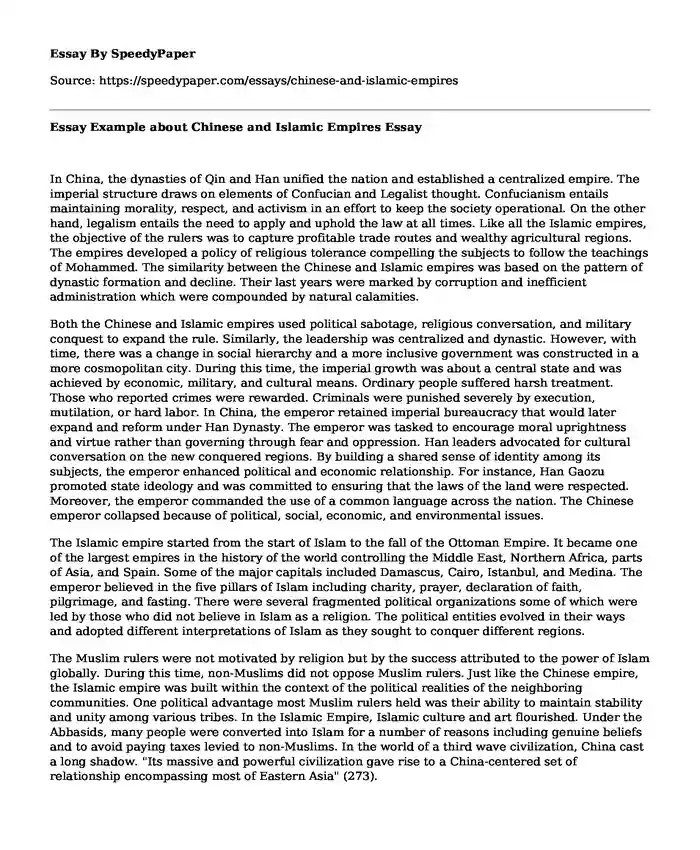In China, the dynasties of Qin and Han unified the nation and established a centralized empire. The imperial structure draws on elements of Confucian and Legalist thought. Confucianism entails maintaining morality, respect, and activism in an effort to keep the society operational. On the other hand, legalism entails the need to apply and uphold the law at all times. Like all the Islamic empires, the objective of the rulers was to capture profitable trade routes and wealthy agricultural regions. The empires developed a policy of religious tolerance compelling the subjects to follow the teachings of Mohammed. The similarity between the Chinese and Islamic empires was based on the pattern of dynastic formation and decline. Their last years were marked by corruption and inefficient administration which were compounded by natural calamities.
Both the Chinese and Islamic empires used political sabotage, religious conversation, and military conquest to expand the rule. Similarly, the leadership was centralized and dynastic. However, with time, there was a change in social hierarchy and a more inclusive government was constructed in a more cosmopolitan city. During this time, the imperial growth was about a central state and was achieved by economic, military, and cultural means. Ordinary people suffered harsh treatment. Those who reported crimes were rewarded. Criminals were punished severely by execution, mutilation, or hard labor. In China, the emperor retained imperial bureaucracy that would later expand and reform under Han Dynasty. The emperor was tasked to encourage moral uprightness and virtue rather than governing through fear and oppression. Han leaders advocated for cultural conversation on the new conquered regions. By building a shared sense of identity among its subjects, the emperor enhanced political and economic relationship. For instance, Han Gaozu promoted state ideology and was committed to ensuring that the laws of the land were respected. Moreover, the emperor commanded the use of a common language across the nation. The Chinese emperor collapsed because of political, social, economic, and environmental issues.
The Islamic empire started from the start of Islam to the fall of the Ottoman Empire. It became one of the largest empires in the history of the world controlling the Middle East, Northern Africa, parts of Asia, and Spain. Some of the major capitals included Damascus, Cairo, Istanbul, and Medina. The emperor believed in the five pillars of Islam including charity, prayer, declaration of faith, pilgrimage, and fasting. There were several fragmented political organizations some of which were led by those who did not believe in Islam as a religion. The political entities evolved in their ways and adopted different interpretations of Islam as they sought to conquer different regions.
The Muslim rulers were not motivated by religion but by the success attributed to the power of Islam globally. During this time, non-Muslims did not oppose Muslim rulers. Just like the Chinese empire, the Islamic empire was built within the context of the political realities of the neighboring communities. One political advantage most Muslim rulers held was their ability to maintain stability and unity among various tribes. In the Islamic Empire, Islamic culture and art flourished. Under the Abbasids, many people were converted into Islam for a number of reasons including genuine beliefs and to avoid paying taxes levied to non-Muslims. In the world of a third wave civilization, China cast a long shadow. "Its massive and powerful civilization gave rise to a China-centered set of relationship encompassing most of Eastern Asia" (273).
Rebellions and movements incorporating popular religious ideas also took place in the last years of the dynasties. The empires wide networks depended upon the ability of the rulers to maintain religious institutions throughout the empire and upon the willingness of the citizens to engage regularly in worship. During this time, most Muslims were beginning to explore the possibility that Yahweh is the only God. Political power was centered in a distinct palace or building in both the Chinese and Islamic Empires. Rulers were chosen based on merit, skill, experience, and reception. China was isolated from any affairs with outside territories. The Chinese believed that the right of the ruler to lead was bestowed by God.
Chinese and Islamic empires played a critical role in technological development. During the rule of Umayyad, scientific knowledge, mathematics, and architecture flourished in certain regions such as Spain. The emperor believed in the value of knowledge. Muslims believed that Allah is all knowing and there was the need for people to seek knowledge from Allah. Muslims presented Allah as the only God, the all-powerful Creator (311). In the Medieval age, the Muslims led the rest of the society in the pursuit of knowledge. In China, various innovations were made including gunpowder, the compass, papermaking, and printing. Further innovation occurred during the Qin Dynasty. Qin created a bureaucracy to centralize control and break the power of feudalists. The lives of women in Chinese and Islamic Empires were quite different. Women played a critical role in political life. Initially, women were regarded as subordinate to men in many realms of public life. However, with time, their roles changed. Other than bearing children, proving food and clothing, and instilling religious and social values, women could become rulers. They were granted ultimate equality in the eyes of the deity.
Cite this page
Essay Example about Chinese and Islamic Empires. (2022, Oct 24). Retrieved from https://speedypaper.net/essays/chinese-and-islamic-empires
Request Removal
If you are the original author of this essay and no longer wish to have it published on the SpeedyPaper website, please click below to request its removal:
- Factors that Influence Health, Free Essay Sample
- Essay Example about Wabash River
- Free Essay Sample on Canadian Federal Government Phoenix Pay System
- Free Essay Example: WeChat Overseas Expanding
- Free Essay Example. Nursing Engagement
- Should the Death Penalty Exist? Get the Answer in Our Essay Example
- Free Essay Example. Sand Cone Method
Popular categories





